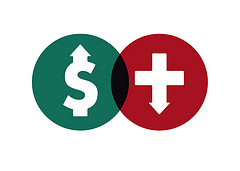 It’s pretty well-known that medical care is absorbing an increasing proportion of GDP, and putting many Americans into financial (and, in many cases, medical) distress. One source of the problem is poverty– people whose incomes are too low to afford decent housing, food etc. are unlikely to have much left over to pay for medical treatments. And another cause might be an aging population who demand advanced treatments to further extend their lives. Both important issues, but this post focuses on another, probably more important one: The medical system is full of rentiers and other thieves, who, pretending to improve health or efficiency, impose tolls or promote unnecessary treatment, resulting in higher and rising costs. That’s the book Marty Makary (MD) has written.
It’s pretty well-known that medical care is absorbing an increasing proportion of GDP, and putting many Americans into financial (and, in many cases, medical) distress. One source of the problem is poverty– people whose incomes are too low to afford decent housing, food etc. are unlikely to have much left over to pay for medical treatments. And another cause might be an aging population who demand advanced treatments to further extend their lives. Both important issues, but this post focuses on another, probably more important one: The medical system is full of rentiers and other thieves, who, pretending to improve health or efficiency, impose tolls or promote unnecessary treatment, resulting in higher and rising costs. That’s the book Marty Makary (MD) has written.
Using a conversational style, well-organized, packed with personal anecdotes, Makary, a cancer surgeon at Johns Hopkins, works his way thru some of the reasons medical care costs so much. Sources are meticulously cited in endnotes. I think his findings can be pretty well summarized:
- Some medical professionals offer screenings and other promotions to entice folks to get treatment they really don’t need.
- Hospital charges are, not quite random, but pretty much void of any relationship to actual costs or what other customers pay for the same service.
- Some hospitals take advantage of their quasi-monopoly status to charge excessive prices, and aggressively sue customers who don’t pay promptly. On the other hand, at least a few hospitals in similar circumstances find they can prosper while charging more reasonable prices.
- Air ambulance (and, to some extent, surface ambulances) have been largely taken over by private equity firms, and impose excessive (mostly unregulated) charges on people who are in no position to bargain.
- Some doctors are outliers in terms of types of birth delivery and various surgeries, meaning that they perform invasive and/or expensive procedures at a much higher rate than the norm. This may be because they’re selfish and inconsiderate, or maybe they just haven’t thought about it and, when shown the data, mend their ways.
- The opioid problem, as reported elsewhere, is partly due to some doctors prescribing more pills than really necessary.
- Overtreatment is a problem; often a more conservative approach is more effective (as well as less expensive).
- A few organizations have managed to rethink how medical care is provided, giving more autonomy to practitioners as well as more support to patients. Also, a few payers (meaning, typically, employers who pay for insurance) are managing to learn the charges imposed by various providers, and incentivizing their insureds to choose less costly providers.
- “Health insurance,” which is really a care financing arrangement and not insurance in the conventional sense, is an even sleazier business than I thought, and insurance brokers are incentivized to maximize costs.
- Pharmacy benefit managers may have seemed like a good idea at one time, but basically are toll collectors between the payer and the drug provider. Similarly, “group purchasing organizations” charge a toll on hospital purchases of equipment and supplies. In both cases it’s rarely possible to get accurate data on who is paying who how much for what.
- Then there’s the “wellness” industry. Of course sensible diets and some exercise are good things, but “wellness” seems to have evolved to divert attention from the main causes of escalating costs.
The book concludes with a few recommendations, mostly for providers and legislators, but also for consumers, who are encouraged shop around, and ask for prices before agreeing to treatment.
A few important concepts are missed.
- The scandal of “Certificate of Need” laws, which protect hospital monopolies and still exist in several backward states, isn’t mentioned.
- While the cost of drugs receives attention, no mention is made of the patent games by which the U S Government enables drug manufacturers to extend protection, and collect rents, far beyond the statutory period.
- Little attention is given to the history of medical care in America, including lodge practice and the role of wealthy foundations in choosing how medicine developed.
Finally, I hope the next edition will avoid doubling the populations of Missouri and Wisconsin (page 79).



